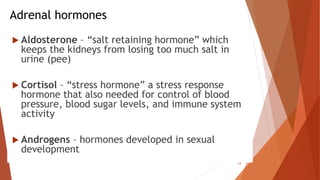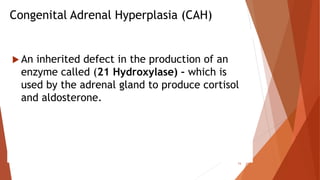Newborn Screening Act
- 1. REPUBLIC ACT 9288 : NEWBORN SCREENING ACT OF 2004 “A drop of blood can save your baby from mental retardation and death.”
- 2. Republic Act No. 9288 Is also known as the “Newborn Screening Act of 2004” It is an act promulgating a comprehensive policy and a national system for ensuring newborn screening The law was developed jointly by the Department of Health and the National Institute of Health of UP Manila. It ensures that every baby born in the Philippines is offered newborn screening
- 3. Why is it important? It primarily checks for 5 metabolic disorders that could affect the health of the child within the first few weeks of life If gone undetected, these disorders may cause severe mental retardation, cataracts, severe anemia Kernicterus or even death for the child However, if these disorders are diagnosed early enough, the child can grow up as a normal healthy human being
- 4. How is the test given? The test should be done 24 to 72 hours after birth Ideally, the test should be a standard operation procedure for hospitals and other birthing facilities The sample will be sent by the hospital to a centralized testing center which is run by the National Institute of Health at its head office in UP Manila The test primarily checks for five metabolic disorders that could affect the health of the child with the first few weeks of life.
- 5. 5 metabolic disorders Congenital Hypothyroidism Congenital Adrenal Hyperplasia Galactosemia
- 7. Phenylketonuria Glucose Six Phosphate Dehydrogenase Deficiency
- 8. Congenital HYPOTHYROIDISM (CH) Congenital means existing at birth (inherited). THYROID A butterfly-shaped organ at the base of the neck AND is part of the Endocrine System. Made up of several glands and tissues that produce hormones. Thyroid Stimulating Hormone HORMONES Hormones are chemicals that send messages to other organs or tissues to the body, telling them to do specific things. 8
- 9. Thyroid hormones 1. Tri-iodothyrodinine (T3) 2. Thyroxine (T4) – crucial for normal growth and development of the body and brain among newborn. 9
- 10. THYROID HORMONE FUNCTIONs Responsible for the normal function of certain body organs and is essential for normal brain development. Controls the development of muscles and bones as well as growth of teeth. Helps maintain heart rate. 10
- 11. Congenital hypothyroidism Hypothyroidism is a condition in which the person does not make enough thyroid hormones. 11
- 12. Congenital hypothyroidism CAUSED BY: Defective development of thyroid gland. Development of thyroid gland in abnormal location. Maternal intake of anti-thyroid medication or excess iodine. 12
- 13. Congenital Adrenal Hyperplasia (CAH) A disorder present at birth and characterized by abnormalities in the production of certain hormones of the adrenal glands. Adrenocorticotrophic hormone If not detected and treated early, babies may die within 7-14 days. 13
- 14. Adrenal hormones 14 Aldosterone – “salt retaining hormone” which keeps the kidneys from losing too much salt in urine (pee) Cortisol – “stress hormone” a stress response hormone that also needed for control of blood pressure, blood sugar levels, and immune system activity Androgens – hormones developed in sexual development
- 15. Congenital Adrenal Hyperplasia (CAH) 15 An inherited defect in the production of an enzyme called (21 Hydroxylase) – which is used by the adrenal gland to produce cortisol and aldosterone.
- 16. 16
- 17. 17
- 18. What does hyperplasia means? Hyperplasia means an abnormal increase in the number of cells that make up an organ or tissue. This causes the organ or tissue to enlarge. 18
- 19. Galactosemia (GAL) GAL is a condition in which the body is unable to process galactose, the sugar present in milk. Accumulation of excessive galactose in the body can cause many problems, including live damage, brain damage and cataracts. 19
- 20. Galactosemia (GAL) An inherited disorder that lacks an enzyme (galactose-1-phosphate uridyl transferase /GAL-1-PUT ) which helps the body to break down galactose. 20
- 21. ) 21
- 22. ) 22
- 23. Phenylketonuria (PKU) PKU is an autosomal recessive metabolic disorder in which the body cannot properly use one of the building blocks of protein called phenylalanine, an essential amino acid that converts into tyrosine causing elevation of phenylalanine in the blood. Excessive accumulation of phenylalanine in the body causes brain damage. 23
- 24. 24
- 26. G6PD Def Is an inherited condition in which the body lacks the enzyme glucose-6-phosphate dehydrogenase, or G6PD, which helps red blood cells (RBCs) function normally. This deficiency can cause hemolytic anemia. G6PD deficiency is an X-linked hereditary disease. 26
- 27. g6pd Is one of many enzymes that helps the body process carbohydrates and turn them into energy. Also protects red blood cells from potentially harmful by products that can accumulate when a person takes certain medications or when the body is fighting an infection. 27
- 28. g6pd Without enough G6PD to protect the blood, RBCs can be damaged or destroyed. Hemolytic anemia is a disorder in which the red blood cells are destroyed faster than the bone marrow can produce them. 28
- 29. What are the five (5) disorders currently included in the newborn screening package? Screened Effect if NOT SCREENED Effect if SCREENED and TREATED Congenital Hypothyroidism (CH) Severe Intellectual Disability Normal Congenital Adrenal Hyperplasia (CAH) Death Alive and Normal Galactosemia (GAL) Death or Cataracts Alive and Normal Phenylketonuria (PKU) Severe Intellectual Disability Normal G6PD Deficiency Severe Anemia, Kernicterus Normal 29
- 30. REFERENCES 30 Congenital Adrenal Hyperplasia. Merc Manual. Sec 19, Ch.269, Endocrine and Metabolic disorders Essentials of Anatomy and Physiology 6th Edition http://www.doh.gov.org. http://www.galactosemia.org






























